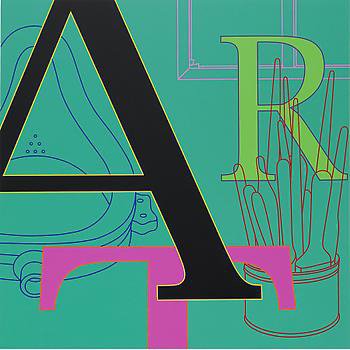Michael Craig-Martin
dal 23/9/2010 al 17/12/2010
Segnalato da
23/9/2010
Michael Craig-Martin
Gagosian Gallery, Athens
His elegant restraint and conceptual clarity is exemplified by An Oak Tree (1973), comprising a glass of water on a shelf and a text written by him asserting that the glass of water is, in fact, an oak tree. The interest in semantics is a core theme in his work.

I want my paintings to be simple enough to seem obvious but complex enough to provide a variety of avenues for imaginative and aesthetic play. Michael Craig-Martin
Gagosian Gallery is pleased to announce an exhibition of new paintings by Michael Craig-Martin. This is his first solo exhibition in Greece.
In his early work, Craig-Martin often incorporated readymades into sculpture and made knowing references to American Minimalism. His elegant restraint and conceptual clarity is exemplified by An Oak Tree (1973), comprising a glass of water on a shelf and a text written by him asserting that the glass of water is, in fact, an oak tree. This interest in semantics, the play between rhetoric and object, continues to be a core theme in his work.
In the 1990s, Craig-Martin made a decisive shift to painting and developed his hallmark style of precise, bold outlines demarcating flat planes of intensely vibrant colors. Through exacting draughtsmanship, he uses composition to explore spatial relationships by juxtaposing and layering color. He paints groupings of letters that may form a number of words; he also depicts banal, manufactured objects. The painted words often refer to abstract qualities and concepts, while the objects are based on the familiar and concrete. However, he does not paint a specific chair, or shoe, or cell phone, but rather a generic typology for each that he repeats throughout his oeuvre. In his eyes, these ambiguous combinations of letters and schematic templates of mass-produced objects create potential for other viewers to derive a range of personal meaning from the paintings.
In his new and vivid acrylic-on-aluminum paintings, Craig-Martin continues his ongoing explorations of reality and representation in art. By constructing a series of open-ended associations and meanings from a set of self-imposed aesthetic limitations – akin to those of language itself –he creates seemingly infinite permutations that expand the imaginative possibilities of his readymade images. Each painting is predicated on a single word, such as “art” or “sign,” which he treats tautologically, interweaving the letters of the word, rendered in varying sizes, with line drawings of quotidian objects such as shoes, hammers, light bulbs, safety pins, and chairs, against a vivid monochrome background. The combined effect of the letters and the objects reduced to pictograms create an illusion of transparency and depth of field; narrative play results from this juxtaposition and layering. Through such apparently random groupings Craig-Martin exploits the complex and often contradictory relationships between word and image.
Michael Craig-Martin was born in Dublin in 1941. He studied at Yale University, where he received his BA in 1963 and his MFA in 1966. He was a professor at Goldsmith's College from 1974-1988 and 1994-2000, and a significant influence on the emerging British artists. Craig-Martin's work is represented in public collections including the Museum of Modern Art, New York; the Tate Gallery, London; and Museo Nacional Centro de Arte Reina Sofia, Madrid. Solo exhibitions include “Always Now,” Kunstverein Hannover (1998); IVAM, Valencia (2000); “Living,” Sintra Museum of Modern Art, Portugal (2001); “Signs of Life,” Kunsthaus Bregenz, Austria (2006); and the Irish Museum of Modern Art (2006-2007). Permanent large-scale installations can be found at Regents Place, London and The Laban Center, Greenwich.
Craig-Martin lives and works in London.
Image: Michael Craig-Martin, ART (green), 2010
Acrylic on aluminum
48 x 48 inches (122 x 122 cm)
Opening September 24, 2010
Gagosian Gallery
3 Merlin Street, Athens
Hours: Mon-Fri 11-6 & Sat by appointment
The gallery will be closed Jul 31 - Aug 31, 2010



